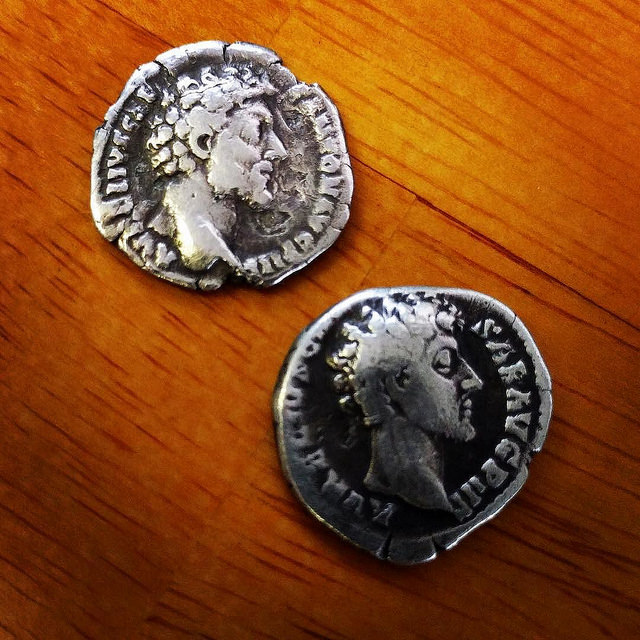
The Complete Roman Army, by Adrian Goldsworthy, provides a pay sheet for one soldier as an illustration of the pay structure for the Roman army.
Pay sheet for one individual soldier
To illustrate the limited documents that survive, Adrian Goldsworthy quotes one document for a soldier in Egypt during 81 A.D. Comment in the book indicates this is one of the best examples of the few documents which are actually known.
Consider what little amount of documentation survives when there would have been three pay sheets for each of the hundreds of thousands of soldiers every year for hundreds of years. Of that massive amount of paperwork relatively few documents remain.
This particular soldiers is assumed to be an auxiliary since his gross pay is equal to 187.5 denarii instead of the 250 denarii for a Legionnaire.
Since this is a quotation of an ancient document I feel free to quote it either because the original document itself in public domain, or in the alternative under fair use.
Information from pay sheet on page 95:
| . | drachmas |
| First pay period | |
| Pay | 247.5 |
| less: | |
| hay | 10.0 |
| for food | 80.0 |
| boots & straps | 12.0 |
| Saturnalia of the camp | 20.0 |
| ? | 60.0 |
| expenditure = | 182.0 |
| balance deposited to account | 65.5 |
| and had from before | 136.0 |
| making a total of | 201.5 |
| . | |
| Second pay period | |
| Pay | 247.5 |
| less: | |
| hay | 10.0 |
| for food | 80.0 |
| boots & straps | 12.0 |
| to the standards | 4.0 |
| expenditure = | 106.0 |
| balance deposited to account | 141.5 |
| and had from before | 201.5 |
| making a total of | 343.0 |
| . | |
| Third pay period | |
| Pay | 247.5 |
| less: | |
| hay | 10.0 |
| for food | 80.0 |
| boots & straps | 12.0 |
| for clothes | 145.5 |
| expenditure = | 247.5 |
| balance deposited to account | – |
| balance added to his account | 343.0 |
Notice the soldier paid for his food and clothes.
Each squad of soldiers (contubernium) was assigned one mule for transport of their tent and equipment. Apparently, the soldiers were charged for the feed eaten by their animal.
Mr. Goldsworthy thinks the difference between 250 drachma pay rate and 247.5 actually paid is due to a 2.5 drachma fee for converting from denarii into drachma. He also points out that drachma is “probably equivalent” to one sestertius, which is one-fourth of a denarii. That would create a conversion rate of four drachma into one denarii.
Of course being an accountant, I have to combine those three pay stubs into an annual statement. I also have to, just have to, convert into denarii.
So here is this particular auxiliary soldier’s pay for the year 81 A.D., expressed in drachmas, denarii, and the disposition of pay as a percent of gross.
| summary | drachmas | denarii | % of pay |
| gross pay | 750.0 | 187.5 | |
| fee for conversion to drachmas | 7.5 | 1.9 | 1% |
| pay, net of conversion fee | 742.5 | 185.6 | |
| . | |||
| deductions: | |||
| hay | 30.0 | 7.5 | 4% |
| food | 240.0 | 60.0 | 32% |
| boots & straps | 36.0 | 9.0 | 5% |
| clothing | 145.5 | 36.4 | 19% |
| ?? | 60.0 | 15.0 | 8% |
| Saturnalia of the camp | 20.0 | 5.0 | 3% |
| to the standards | 4.0 | 1.0 | 1% |
| total deductions | 535.5 | 133.9 | 72% |
| xx | |||
| after deductions | 207.0 | 51.7 | 28% |
| previous year balance | 136.0 | 34.0 | |
| ending balance | 343.0 | 85.7 |
Several things jump out from that information.
First, food consumed about 1/3rd of his pay.
Second, clothes were about 1/5th of his pay.
Third, the soldier was reasonably frugal and did not pay many bribes to his centurion to get out of dirty tasks. As a result, he ended the year with about 1/3 of his pay left over. He has a rather healthy balance saved up at the end of the year, with just under one half of a year’s pay in his account.